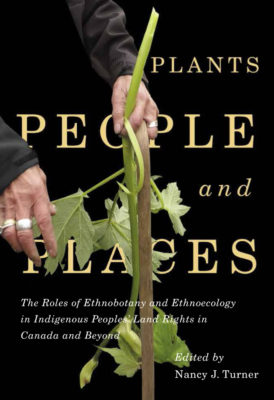In their introduction to the important new collection Plants, People, and Places, editor Nancy J. Turner and her collaborators write that “the concept of ‘wilderness’ was in fact a colonizer’s fiction in many respects.” The worldview supported by this fiction has had an enduring and catastrophic influence on the lives of Indigenous peoples around the world, justifying violent land theft and providing little recourse for Indigenous land claims in the absence of traditional European notions of sustained occupancy – built structures, cleared and cultivated fields, etc. While it may be widely understood that Indigenous peoples “used” their ancestral lands, the extent and diversity of Indigenous land management and intensive, long-term plant stewardship have been largely overlooked.
This volume brings together Indigenous traditional knowledge holders, Indigenous scholars, and settler scholars, whose varied contributions convincingly demonstrate that the biological character of North America has been shaped by millennia of intentional, knowledgeable landscape management. Seeding and tending crops to ensure concentrations of certain species, controlled burning to encourage the growth of berries and young plants, and coppicing and selective harvesting of trees are just a few examples of the interventions that early European observers misinterpreted as naturally occurring or unintentional.
As several archaeologists in the collection discuss, these interventions are difficult to document in the material record of the land and therefore often fail to meet the legal threshold for “occupancy” in title cases. This volume argues that the work of ethnobotanists and ethnoecologists is crucial to asserting Indigenous rights and reinterpreting such colonial definitions. Ethnobotany and ethnoecology document “the rich environmental knowledge of people with enduring relationships to particular plants and habitats,” including practical knowledge of how to harvest and use plants, and the cultures, values, and language that emerge in relationship with specific ecosystems. This volume makes a strong case that such knowledge can and should be incorporated into policy, planning, and decision-making processes regarding land title, conservation, and environmental risk and resiliency.

Plants, People, and Places
The Roles of Ethnobotany and Ethnoecology in Indigenous Peoples’ Land Rights in Canada and Beyond
Edited by Nancy J. Turner
McGill-Queen’s University Press
$49.95
cloth
554pp
9780228001836
The influence of distinguished ethnobotanist Turner is beautifully apparent throughout the collection. Although many chapters discuss Canadian legal contexts, the book is really about British Columbia, Turner’s area of expertise, with only scattered references to other parts of Canada alongside a handful of articles about other countries. Countless descriptions of camas (an important edible root cultivated on the West Coast) might be a pleasant accretion of detail about an interesting topic, or may become repetitive for readers left wondering about other plant traditions across the continent based on the book’s title and the publisher’s jacket description. However, the broader value of the volume is augmented by the lengthy bibliographies accompanying each article, citing secondary literature across disciplines, court proceedings, and policy documents. In this way, the book will be an invaluable reference work and resource for anyone interested in ethnobotany and ethnoecology in British Columbia or elsewhere.
The book ultimately supports a liberal vision of Canada, and Turner situates the work as an act of hope that might “lead Canada into a more just, more sustainable relationship with Indigenous peoples and with the plants and environments on which all of us depend.” Emerging from a symposium in 2017, the volume is marked by the optimism so prevalent in the period following the release of the Truth and Reconciliation Commission report in 2015, optimism which has since been somewhat deflated in light of Canada’s ongoing assault on Indigenous land rights. Nevertheless, Plants, People, and Places confidently and compellingly asserts the value of ethnobotany and ethnoecology to the ongoing legal challenges of Indigenous peoples, and to the broader resurgence of Indigenous cultures around the world. mRb






0 Comments